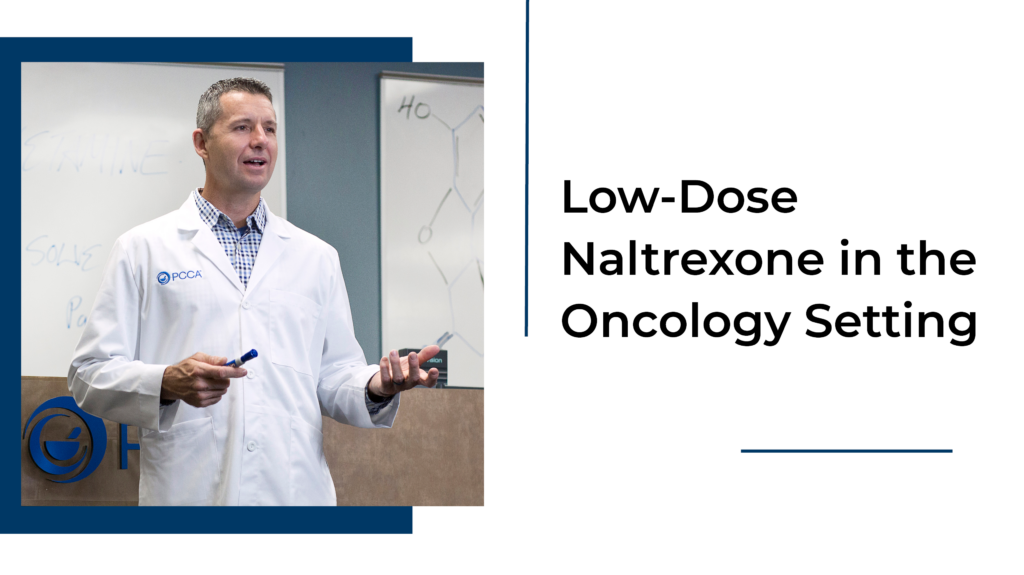Low-Dose Naltrexone in the Oncology Setting

by Sebastian Denison, RPh, PCCA Clinical Compounding Pharmacist
Since 2014, there’s been an explosion of information about the potential applications of low-dose naltrexone (LDN), including its use as an adjunct therapeutic in some types of cancer. The exploration of LDN in cancer treatment underscores the importance of understanding the complex interplay between immune signalling and cancer biology, which we discuss in the following article.
Understanding TLR Signaling and Inflammation
Toll-like receptors (TLRs) play a crucial role in detecting and responding to pathogens and initiating inflammation. TLR signalling culminates in the activation of key transcription factors such as nuclear factor kappa B (NF-κB) and activating protein-1 (AP-1).
These transcription factors regulate a multitude of genes, including those encoding important proinflammatory cytokines such as tumour necrosis factor-alpha (TNF-alpha) and interleukins (IL-1, IL-6, IL-8, IL-12). Some TLRs also activate the production of type 1 (alpha and beta) interferons by inducing the interferon regulatory factors (IRFs) IRF3, IRF5 and IRF7.1
NF-κB has been implicated in the pathogenesis of a number of inflammatory diseases, such as rheumatoid arthritis (RA), inflammatory bowel disease (IBD), multiple sclerosis, atherosclerosis, systemic lupus erythematosus, type I diabetes, chronic obstructive pulmonary disease and asthma. It also links chronic inflammation to cancer.2
Ongoing inflammation can also contribute to a condition known as “inflammaging,” characterised by elevated inflammatory markers in older adults, increasing their susceptibility to chronic diseases and frailty.3
LDN: A New Perspective in Oncology
Traditionally, naltrexone (NTX) was used in treating opioid and alcohol dependence. Emerging research indicates that LDN may have a significant impact on cancer progression. This is primarily mediated through its effects on the opioid growth factor receptor (OGFr) axis, which has been associated with cancer cell survival, proliferation and invasion.4
Mechanisms of Action
- Antagonism of Receptors: LDN’s antagonistic effects extend to TLRs 7-9, which can lead to the suppression of IL-6, a cytokine often elevated in cancer. By inhibiting these receptors, LDN may help to modulate the inflammatory environment that tumours exploit for growth.
- Modulation of Immune Function: LDN appears to enhance the immune response in patients, potentially leading to improved cancer control. By promoting the activity of immune cells, LDN may assist the body in recognising and attacking cancer cells more effectively.
- Inhibition of Signalling Pathways: LDN is shown to prime pro-apoptotic pathways, encouraging cancer cells to undergo programmed cell death. This mechanism is particularly advantageous in combination with other therapies, such as chemotherapy and immunotherapy.5
Low vs. Standard Dose
The effectiveness of NTX is highly dependent on individual dosage. Standard doses (25-50 mg) exhibit a classic antagonistic effect on opioid receptors, while LDN (1-5 mg) creates a transient blockade. This low-dose administration results in a compensatory increase in the synthesis of endogenous opioid peptides, fostering a feedback mechanism that enhances the anti-cancer effects. Research led by McLaughlin emphasises the importance of both dosage and duration of exposure to opioid receptor antagonists. LDN’s temporary blockade of the OGFr ultimately leads to an increase in the expression of various opioid receptors, which can inhibit DNA replication and limit cancer cell proliferation. Conversely, higher doses of NTX could promote cellular division, counteracting the intended therapeutic effects.6
Promising Preclinical Evidence
Numerous preclinical studies support the idea that LDN can positively impact cancer outcomes. These studies indicate that LDN may inhibit the OGFr-OGF signalling axis, leading to decreased cancer cell proliferation. The lack of direct cytotoxic effects, combined with its immunomodulatory properties, positions LDN as an appealing option for cancer patients, particularly when used in conjunction with conventional therapies.
As anecdotal reports and preliminary studies point towards its efficacy, there is a growing momentum for clinical trials assessing LDN in oncology. The promise of LDN lies in its unique mechanism of action, which harnesses the body’s own systems to combat cancer while potentially reducing the side effects associated with traditional chemotherapy.
Contact our Clinical Services Team for help with PCCA formulas and other compounding questions.
References
- McDonald D. Toll-like receptors: Roles in disease and therapy. UpToDate (2022; literature review current through May 2024). Accessed 2024 at https://medilib.ir/uptodate/show/3985
- Liu T, Zhang L, Joo D, Sun SC. NF-κB signaling in inflammation. Signal Transduct Target Ther. 2017;2:17023-. Accessed 2024 at https://pubmed.ncbi.nlm.nih.gov/29158945/
- Ferrucci L, Fabbri E. Inflammageing: chronic inflammation in ageing, cardiovascular disease, and frailty. Nat Rev Cardiol. 2018;15(9):505-522. Accessed 2024 at https://pubmed.ncbi.nlm.nih.gov/30065258/
- Belltall A, Mazzinari G, Diaz-Cambronero O, Eroles P, Argente Navarro MP. Antagonists of the Mu-Opioid Receptor in the Cancer Patient: Fact or Fiction? Curr Oncol Rep. 2022;24(10):1337-1349. Accessed 2024 at https://pubmed.ncbi.nlm.nih.gov/35648340/
- Liu WM, Dalgleish AG. Naltrexone at low doses (LDN) and its relevance to cancer therapy. Expert Review of Anticancer Therapy, 2022;(3), 269–274. Accessed 2024 at https://www.tandfonline.com/doi/citedby/10.1080/14737140.2022.2037426?scroll=top&needAccess=true
- Ciwun M, Tankiewicz-Kwedlo A, Pawlak D. Low-Dose Naltrexone as an Adjuvant in Combined Anticancer Therapy. Cancers. 2024; 16(6):1240. Accessed 2024 at https://www.mdpi.com/2072-6694/16/6/1240
Back to news
Can’t find what you’re looking for?
If you can't find what you're looking for contact our team to discuss your needs in more detail.
Talk to one of our team